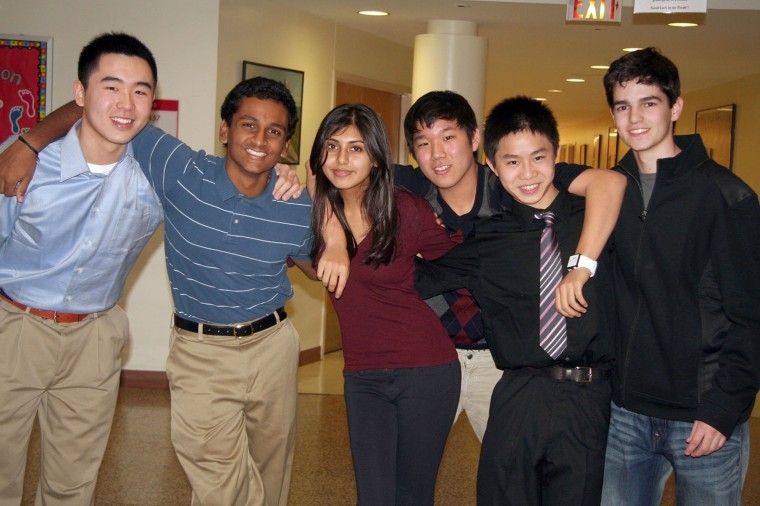After 400 hours of research, Wheatley senior Sonya Prasad could become the first student in the school’s history to win the national Siemens Math, Science and Technology competition this weekend in Washington, DC.
“I’m a little worn out,” Prasad said as she sat in a lab room at Wheatley to discuss the topic that put her in the finals – a study of engineering nanoscale biosensors to enable relatively easy detection of pancreatic cancer.
Prasad is part of a three-student team that undertook the research that put them in the running among five other team finalists in the competition. She and her project partners, Nikhil Mehandru of Roslyn High School and Santosh Narayan from Munster High School in Munster, IN, formulated and conducted their research during seven weeks at a Stony Brook research lab this past summer.
She is one of several outstanding Wheatley science students who have gone through a series of lab experiences since middle school that put them in the running for a $100,000 college scholarship.
Prasad said she and her partners selected pancreatic cancer because it has a particularly high mortality rate. Their objective was to find a relatively inexpensive detection method using biomarkers to collect data on the toxicity of extremely tiny particles in pancreatic cancer cells.
“The method we used to detect cancer is fairly new,” she said.
Prasad said she is “definitely nervous” about the outcome of the competition. But win, lose or draw she said she is is contemplating following in her parents footsteps and to pursue a career in medicine or some scientific field. Prasad’s mother, Nalini, is an anesthesiologist and her father, Kris, is an engineer,
Just entering an elite science competition like Siemens is good college resume grist. And like many of her science-minded peers, Prasad demonstrates other conspicuous talents: she won a place as a vocalist in the upcoming NYSSMA state competition.
Prasad is one of an elite group of highly motivated students who seek lab work opportunities and express their competitive natures through their academic work.
“Part of it is you want kids who are bright enough so they can learn what they need to know to present their projects,” said Doreen D’Angelo, one of Wheatley’s two lab science teachers who direct the exceptional students. “The other thing is, these kids are very competitive.”
Wheatley juniors Alan Czermerinski and Tom Wang were named Siemens semi-finalists for their work on using oxygenated and de-oxygenated hemoglobin cells to detect the flu virus. They plan to extend their research to use another form of hemoglobin, the stuff blood cells are built from, to detect high levels of blood sugar or diabetes.
“We work toward coming to Siemens. That program is geared to just teaching itself,” said Czermerinski.
Both he and Wang aspire to careers in biological engineering. They collaborated on their project developed during lab work at Stony Brook with Kelsey McKenna of Southside High School
And both students are also musicians. Wang plays the clarinet, while Czermerinski plays french horn and will be joining Prasad at the NYSSMA state music competition.
Wheatley junior Lambert Chu was named a Siemens semi-finalist for his work with a partner from the Philips Academy in Massachusetts on determining the genetic effect of morphine on cancerous and non-cancerous cells.
Chu and his partner built on prior research with morphine in this vein by exposing healthy and unhealthy cells to various morphine dilutions.
“What morphine does is destroy cells to inhibit tumors from growing,” Chu said, adding that he stumbled upon related research while at the research lab at CUNY Old Westbury this past summer.
Wheatley juniors Arjun Balakumar and Sean Oh gained recognition as Siemens semi-finalists by exploring the effects of Docosahexanaenoic Acid (DHA) and Lithium Chloride on Alzheimer’s Disease.
They had a toxic substance, 4NP, known to “stress” cells, Oh said, leading to Alzheimer’s. Using 4NP to do just that, Oh and Balakumar were able to demonstrate that the combination of DHA and Lithium Chloride reduced the plaque that builds up in arteries to cause Alzheimer’s Disease.
“It was a synergetic response. They work best when combined together,” said Oh.
Oh said he plans to continue doing research on Alzheimer’s and the immune system, and wants to major in neuroscience.
Consistent with the profiles of his fellow Siemens standouts, Oh also has a musical side: he plays cello and guitar.



